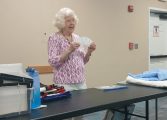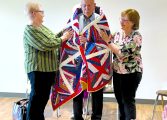By Page H. Gifford
Correspondent
Artist Leah Olivier made her third appearance Friday at the monthly Fluvanna Art Association meeting. Her topic was about the principles of art and their influence on the composition. Her underlying message was about intent when designing artwork.
“Your art needs to be more, make your mark, it needs to have you in it, it needs your intention.” To accomplish this and create artwork that has meaning, Olivier discussed in depth the principles of art.
“We are not going back to art school,” she told the members who looked reluctant to accept a new concept in art. Without extensive art training or study, this was new to some. Olivier has a way of using humorous honesty to get her point across clearly and concisely. “The principles of art create better work,” she said. “Overworked art that is realistic down to every last detail has no emotion, no message, no intent.”
She briefly mentioned reference photos, cautioning not to copy every detail but use it for a starting point for creation, an idea.
“Loosen-up, don’t be so tight or perfect. That first sketch is the beginning of a painting and should not be your final. It’s not your baby, let it go, it’s paint on a canvas, and if this is not happening, you missed the concept,” she said. “The goal is to get people to feel what you meant.”
She showed examples, including a large canvas of a dog content and happy, bright, alert eyes and tongue hanging out to the side, conveying an expression of joy. Upon seeing it, everyone laughed and Olivier got the response she wanted from the work. It was not overdone and the details were few but enough to be realistic.
“The principles of art are rules that help you analyze art. There has to be balance and harmony in a piece.” She added that the piece needs a focal point to draw the eye inward.
Color is key but contrast is important in seeing the difference in values. This is central to rendering light and shadow to give a picture mood.
“Contrast will get your attention,” she said. “Repetition and pattern add interest. Using a variety of patterns creates rhythm and excitement for the viewer.” This is connected to movement, drawing the onlooker further into the painting not just looking at it.
“These basic principles of art are to be used with intention.” She added the basic elements of art can be used in conjunction with the rules to achieve intention. The elements are the foundation of art, its structure, using line, color, values, texture, space, and form. The elements are the nuts and bolts while the principles are the guidelines for making exceptional art.
“This is not a checklist, you don’t need all of them (elements) but they will help you reach your goal.” She showed various photos and discussed symmetry. “Look at your photos can they make better paintings or do the photos stand on their own?”
She said the beginning of any planned art requires intention which is telling a story and creating a relationship. She strongly suggested drawing thumbnails, using the principles to get the best composition and angles.
“Look at your negative shapes, they can give you the visual you’re looking for,” she said. “Watch your edges and lines. If they are hard the eye can’t rest and use implied lines, roads, paths, streams, are all implied lines.” By using the famous rule of thirds for landscapes, she reminded them of foreground, middle-ground, and background, otherwise everything appears flat and lacks depth.
“Watch color, let it pop enough but not too much by letting the chroma overwhelm your piece. It pops too much, alter it. And always have drama in your work. Find the flow, tension, and balance.” Understanding the components of good art may have seemed intense for some, but a worthwhile lesson for most.
She reminded the members that “Artists are illusionists.”




